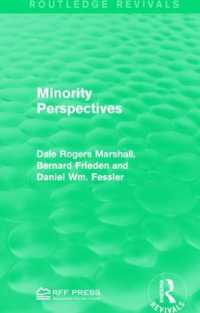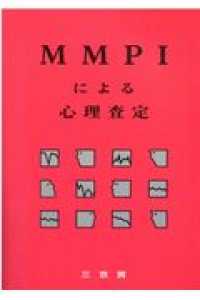- ホーム
- > 洋書
- > 英文書
- > Science / Mathematics
Full Description
Volume II of Geospatial Information Handbook for Water Resources and Watershed Management discusses Geospatial Technology (GT) approaches using integrated modeling as applied to advanced water resource assessments. Features include multiple date land cover analyses as change in land cover influences water quality, model sensitivity analyses of DEM resolution and influences on modeling water characteristics like Manning's n, development of seabed cover classification and sensitivity, and forecasting urban growth over time with climate vulnerability impacts on water. A detailed case study presents a range of water quality issues, all effectively demonstrating GT inputs to water quality studies from headwaters to receiving estuarine waters. Also analyzed are the comparison of evapotranspiration simulation performance by APEX model in dryland and irrigated cropping systems and perspectives on the future of transient storage modeling.
Captures advanced technologies and applications for implementation with models to address a broad spectrum of water issues
Provides real-world applications and case studies using advanced spectral and spatial sensors combined with geospatially facilitated water process models
Features a Neuse River Basin case study integrating hydrologic methods and modeling along with remote sensing and GIS technologies for nonpoint source water quality evaluations
Global coverage with applications demonstrated by more than 170 experts from around the world
This handbook is a wide-ranging and contemporary reference of advanced geospatial techniques used in numerous practical applications at the local and regional scale and is an in-depth resource for professionals and the water research community worldwide.
Contents
1. Introduction to Volume II and Neuse River Watershed and Water Quality Case Study, 2. Neuse Case Study and Water Quality-Related Methods, 3. Virtual Field Reference Database for Assessment of Land Cover Data and Variability, 4. Vegetation Dynamics and Identification of Land Cover Change in a Complex Land Use Community, 5. Land-Cover Change Detection Using Multi-Temporal MODIS NDVI Data, 6. Spectral and GIS Rule-Based Land-Cover Classification in the Neuse River, 7. Modeling the Distribution of Diffuse Nitrogen Sources and Sinks in the Neuse River Basin, 8. Monitoring of Water Colorants Using AVIRIS Hyperspectral Sensing, 9. DEM Resolution and Roughness Effect in Relation to Model Performance, 10. Application of Densely Stacked Satellite Image Classification and Multinomial Logistic Regression Analysis in Predicting Urban Sprawl, 11. A Feasibility Study of Seabed Cover Classification Standards







